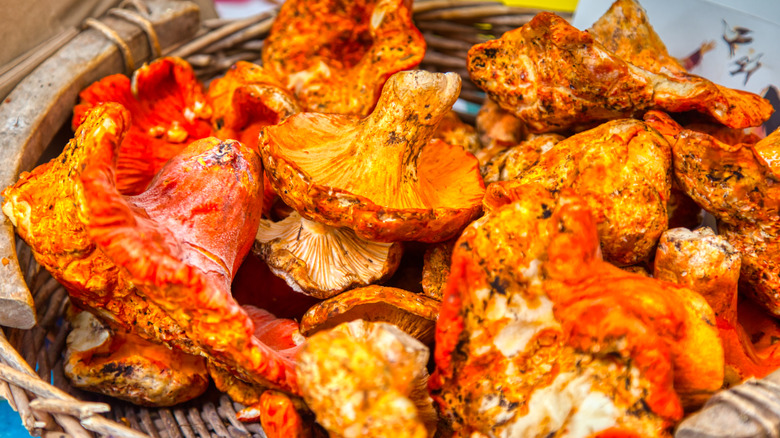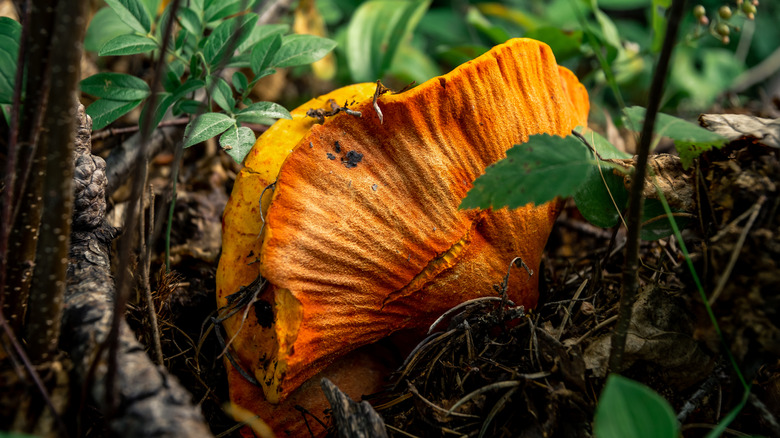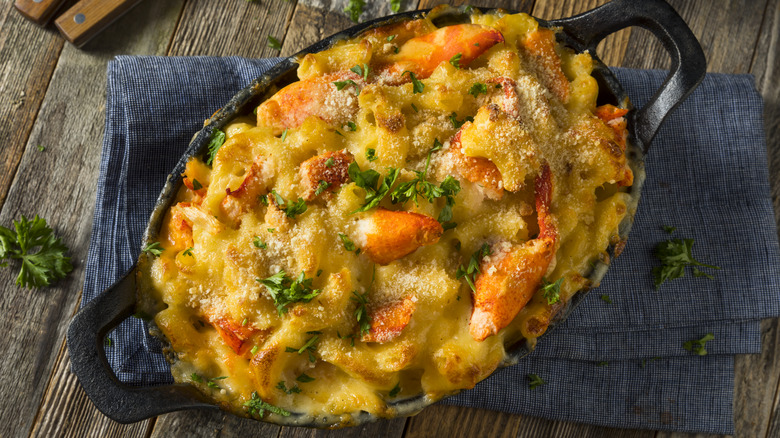The Hardest Part Of Cooking Lobster Mushrooms Is The Cleaning
Lobster mushrooms are quite similar to their oceanic counterpart. Alluring in color, lavish in taste, and most frequently harvested in New England, these vibrant 'shrooms are prized for their tender meat and oceanic aroma. But unlike those in the deep blue, forest-dwelling lobsters are hard to come by. They only grow during certain parts of the year and require adept foraging skills, mostly because they aren't technically mushrooms at all. Instead, they are an invasive parasite.
Think of the game or TV show 'The Last of Us,' where parasitic fungi take over the everyday functioning of a living organism. What was once your average Russula or Lactarius mushrooms are essentially "infected" by an invasive fungus called Hypomyces Lactifluorum. This parasite then morphs the mushrooms' texture, taste, and overall presentation into what we know today as the lobster mushroom. These fungi are expert hiders on the forest floor; if you have a keen eye, their tawny color is easy to spot and uproot. But once you do, they will likely require a deep cleaning.
Lobster mushrooms have a complex design. There are folds, ridges, and a deep epicenter filled with soil. They cannot be washed, nor can they be soaked. So, the best method to clean your lobsters is to use a dry brush. This will strip the mushroom of any external impurities that may be lingering. You can use a toothbrush after harvesting and again in the kitchen once sliced down the middle.
Why you should clean your mushrooms before eating them
Like all other mushrooms (or parasitic fungi), lobsters require an in-depth cleaning to exfoliate their natural gunk and grime. Thick layers of dirt may coat the outside and prevent you from seeing any damage, soft spots, or hubs of insects below. Even if you don't eat them right away, it's essential to clean them. One such creepy crawler that resides in 'shrooms are springtails. Their name does not depict the type of season they are most prevalent in, but rather their characteristic "springing" or jumping.
Other than springtails, your lobster may be harboring hoards of wormy larvae, ticks, slugs, snails, ants, or maggots. In fact, the FDA legally allows up to 20 maggots and 75 mites per can of mushrooms. That said, you "mite" want to leave those wriggling pests where you found them. Or, you can scrape off as much as possible before bringing them home for further cleaning. As previously mentioned, lobster mushrooms – although sturdy – should not be soaked in a bowl. This will rid the fungi of their beautiful coloration and make them waterlogged or mushy. Use paring knives, soft toothbrushes, or specialty harvesting tools to initially clean the lobster's unique folds and crevices. However, if any remains, you can quickly rinse parts of the lobster with chilled water. Just ensure they dry completely before cooking.
Lobster mushrooms are the perfect companion for vegan pastas
Lobster mushrooms can be used almost interchangeably with the native sea creatures. While they don't taste exactly the same, they are a great replica to use in vegetarian or vegan-inspired dishes. Plus, you don't have to be a kitchen expert to cook lobster pasta – you just need butter. This type of concentrated fat is one of the best ingredients to use while sautéing sliced lobster mushrooms. It softens the fungi's sturdy exterior and draws out its aquatic taste and smell, making it a palatable addition to chowders, sandwiches, and most importantly, pasta.
You can eat all parts of the lobster mushroom, including the stem. Mushroom stems are a fun addition to homemade stews and chowders that provide both texture and deep taste. Still, you want to keep an eye out for how long your mushroom has been cooking. Like seafood that has been kept past its prime, expired or undercooked Russula lobster mushrooms can make you unwell. Avoid any lobster that has darkened in hue or become purple. If you plan to store your lobster mushrooms for use at a later time, store them in a paper sack and refrigerate. Discard after a few days or if they take on an extremely fishy odor. Lastly, lobster mushrooms can be preserved in the freezer for up to a year. Remember that freezing does not reverse an ingredient's use-by date; it only decelerates it.


